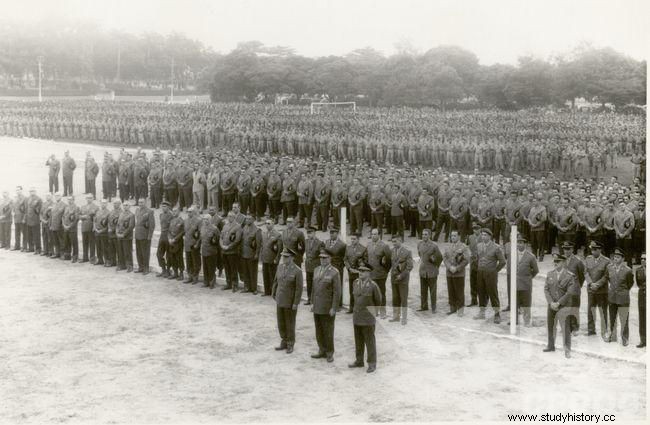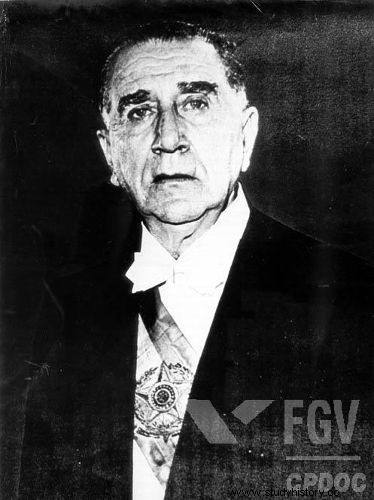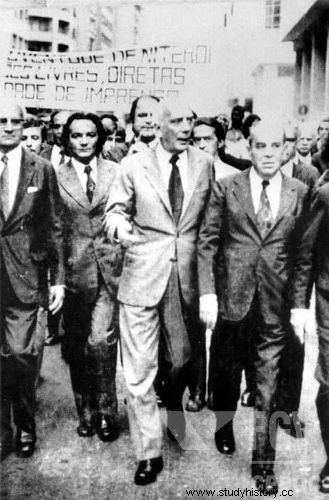The Military Dictatorship is what we call the period in which the military governments were at the head of Brazil, between 1964 and 1985. The period of the Military Dictatorship was one of the most tense in Brazilian history and was marked by the lack of freedom, by the use of torture against opponents politics and the practice of State terrorism.
The Military Dictatorship was initiated by a civil-military coup held in 1964, against then president João Goulart. The military began to impose an authoritarian regime which was sustained by institutional acts . During the 21 years of dictatorship, Brazil had five “presidents-generals”. The balance of the dictatorship was 434 between dead and missing , in addition to the death of thousands of indigenous people.
Login also :JK government - one of the main governments of the Fourth Republic period
1964 coup:beginning of the Military Dictatorship in Brazil

The 1964 coup was the event that promoted the establishment of the Military Dictatorship in Brazil. This coup was started on March 31, 1964 , when the military installed in Juiz de Fora rebelled against the government, and it was concluded on April 2, when Brazilian parliamentarians ratified the dismissal of João Goulart . The coup, therefore, was initiated by the military, but also had political and civilian support.
The 1964 coup was the conclusion of a long-standing project aimed at the overthrow of Labour – a project that defended the developmentalism of the economy and the promotion of social well-being for the population – and the imposition of an agenda that promoted the modernization of Brazil through an authoritarian way.
João Goulart, also known as Jango, was a gaucho politician who had risen in Brazilian politics at the national level during the 1950s. considered one of the great successors of Getúlio Vargas . In 1961, a political crisis led João Goulart to the presidency.
Jango took over the presidency, because Jânio Quadros had resigned from his position in August 1961. As Jango was vice president, the Constitution demanded that he be sworn in, which happened on September 7, 1961. The tensions that existed in Brazil increased with the president's reform project known as Base Reforms .
The Basic Reforms were a project that stipulated structural reforms in Brazil, with the objective of reduce inequalities and, based on that, guarantee the country's development. They generated a lot of dissatisfaction, especially the reform agrarian, project that guaranteed access to land for the dispossessed and harmed the interests of large landowners.
In addition, Jango's political relationship with workers and unions was seen by Brazil's middle and upper classes as an indication of communism . This same interpretation was made by the US government in relation to Jango, mainly because that time was the height of the Cold War, and the United States had just gone through McCarthyist hysteria.
All of this brought the military, Brazil's economic elites and the US government closer together. The result of this was the birth of a conspiracy against the president . The US government, through the CIA, sent money to Brazil to finance conservative political candidates, from the Brazilian Institute for Democratic Action (Ibad).
In addition, the Institute for Research and Social Studies (Ipes), a front group that presented itself as an organization that carried out studies about Brazil and Brazilian society, but which served as a secret meeting point for the military and high business in Brazil to meet to overthrow Jango.
There was also extensive press involvement in the coup, mainly through the Rede da Democracia , an association between major newspapers in Brazil that came together with the aim of making criticisms in order to promote the collapse of Jango's government. It had the involvement of the three largest journalistic companies in Brazil:Globo , Newspaper from Brazil and Journals Associates .
Politically, João Goulart's government was bad, as he proved to be hesitant and failed to capitalize on support to promote agrarian reform. The result was that he became isolated, losing considerable support in the Social Democratic Party (PSD). In March 1964, he tried to move his government further to the left, as dialogue with the right and center had failed.
With that he made the speech at the Central do Brasil rally announcing its commitment to Grassroots Reforms. The result of the conservative groups occurred with the March of the Family with God for Freedom , held in São Paulo and with around 500 thousand people. From there, the wear and tear extended and days later the coup occurred.
On March 31, 1964, the military of the 4th Military Region in Judge from Out started a rebellion against the government under the leadership of Olímpio Mourão Filho . There was no response from the government, and the military rebellion increased, reaching Rio de Janeiro and Brasília. On April 2, 1964, the senators, through an extraordinary session led by Auro de Moura , consolidated the coup by declaring that the country's presidency was vacant.
This concluded the coup that overthrew João Goulart and temporarily installed Ranieri Mazzilli as president of Brazil. On April 9, the first military president of the dictatorship was appointed:General Humberto Castello Branco . The military also granted the Institutional Act nº 1 , which imposed the first authoritarian measures of the dictatorship.
Many historians treat the 1964 coup as a “civil-military coup. ” and not just “military”. This is justified by these historians by the fact that the 1964 coup was carried out through a great deal of articulation between the military and between civilians, since there was a conspiracy in progress, since 1962, and that once the overthrow of Jango by the military, the civilians, that is, the parliamentarians, chanceled the coup , even though it was illegal under the 1946 Constitution. To learn more about the two phases of João Goulart's government, access:first phase and second phase.
Who ruled Brazil in the Military Dictatorship?
In the 21 years of the Military Dictatorship, Brazil had five military presidents and they were all indirectly elected , that is, without the participation of the population in the selection process. The fact that the Military Dictatorship in Brazil had “presidents” and not just a dictator – as was the case in Chile and Argentina – is symptomatic of the military’s original intention:they wanted to present an air of normality .
The existence of five presidents demonstrates the military's interest in demonstrating that the country was as normal as before, as we were supposedly governed by presidents and not dictators. But it is important to realize that, while the country “demonstrated normality” with the appointment of presidents, the opposition was persecuted and freedom in the country was curtailed.
So, “normality” was just a facade to hide the real facet of dictatorship :authoritarian and violent. Journalist Elio Gaspari even calls the dictatorship a “shameful dictatorship”, since it was authoritarian, but sought to mask its authoritarianism to present itself as democratic.
In any case, the five presidents of the period were:
- Humberto Castello Branco (1964-67);
- Artur Costa e Silva (1967-69);
- Emilio Doctor (1969-74);
- Ernesto Geisel (1974-79);
- John Figueiredo (1979-85).
Repression and Authoritarianism

The Military Dictatorship was a period of exception , that is, it was a period of repression of the civil and political rights of the population and of concentration of power in the military, the group that commanded Brazil. The military justified all the abuses on the basis of the Doctrine of National Security , used to go after all those who allegedly threatened national security.
As such, arbitrary arrests, kidnappings, expulsions, invasions of property, torture, murders of citizens, disappearances of corpses and even bombings were carried out by the State. , always with the justification of fighting subversives , those who allegedly threatened the country.
Brazil's legal legislation was imposed through institutional acts , decrees with the power of law, which allowed the military to act in an authoritarian manner. During the dictatorship, nineteen institutional acts were granted , the most famous of which was the AI-5 , the most rigid and responsible for initiating the most rigid period of the dictatorship.
Institutional acts allowed the military regime to revoke political mandates – in 1964, this was done on a massive scale –, to amend the constitution, revoke political rights from citizens, withdraw the right to vote of the Brazilian population, impeachment of all political parties that existed in the country, close Congress, dismiss public servants, intervene directly in state and municipal governments, etc.
The Military Dictatorship also repressed free thinking and hundreds of book publications were banned, as well as the circulation of these books. Universities began to be monitored, student movements were persecuted and government agents were infiltrated in university circles to monitor everything that was said in these places.
In politics, a major restriction was imposed on the Brazilian political system, and all the parties that existed in the Fourth Republic were replaced by the Aliança Renovadora Nacional , the Arena, and the Movement Democratic Brazilian , the MDB. Arena was the party of the military, while the MDB played the role of consenting opposition.
Login also :History of elections in Brazil – evolution of the electoral system
Torture
One of the greatest horrors committed by the Military Dictatorship, without a doubt, was the torture , which was one of the ways of persecuting and fighting opponents of the regime. Torture also occurred with people who had no direct relationship with the dictatorship, as in the case of children of political prisoners who were tortured so that their parents would denounce allies.
Torture happened in every way possible and new studies suggest that much of the torture techniques were exported from the French army (who used them in the wars fought in Indochina and Algeria). Among the techniques used are the pau de macaw , the use of electric shock , the use from palmatory etc.
The torture was not just physical, but psychological , as political prisoners were left in solitary confinement for days, they were threatened with having their family members harmed, in addition to their children being used by the military as a source of information. In all, it is speculated that around 20,000 people were tortured by the dictatorship in Brazil .
Resistance Movements

Despite 21 years of dictatorship, the military has always had to face strong opposition in society. This opposition manifested itself in the politics , in the arts , in sport etc. Since the beginning of the regime, demonstrations against the military took place and were violently repressed. The cycle from 1964 to 1968 was marked by gigantic demonstrations by students and workers.
This period was also marked by political opposition, the most notorious case being that of the Broad Front . This movement was created by Carlos Lacerda , a supporter of the 1964 coup, who had turned to the opposition when his interests in running for president in 1965 were thwarted by the hardening of the regime.
The Frente Ampla was founded in 1966, with the support of Juscelino Kubitschek (senator in 1964 and connived in the coup) and João Goulart (dropped by the blow). The Frente Ampla demanded the return of democracy in Brazil and ended up being banned from functioning by means of a determination of the Ministry of Justice, in 1968.
Politicians also refused to punish Márcio Moreira Alves, a deputy who called the Armed Forces a “valhacouto of torturers”. This, supposedly, would have been one of the factors in the hardening of the regime – the military did not accept open opposition from politicians and, therefore, decided to harden the regime.
The hardening of the regime was also the cause ofarmed guerrilla warfare in Brazil. With intense repression and authoritarianism, many opponents decided to launch an armed struggle, as they had no opening to express their dissatisfaction. It was the way found by some groups to resist. Two names stand out in the armed struggle:Carlos Marighella and Carlos Lamarca . The dictatorship's intense repression of the armed movements made them disappear in a matter of a few years.
AI-5
Institutional Act nº 5 was the worst of the AIs enacted by the military dictatorship, that is, the most rigid and authoritarian of them. It was granted on December 13, 1968, and opened the darkest period of the dictatorship, being the final result of the military strategy to extend the dictatorship in Brazil. The AI-5 concluded the interests of the Armed Forces to promote the hardening of the dictatorship and the phase of apparent democracy (1964-68) was ended. This phase of apparent democracy is the phase where the military was little by little organizing the repressive apparatus and getting the population used to the new reality.
AI-5 and the conditions for its institution were meticulously elaborated by the dictatorship and new studies suggest that a series of bombings were carried out by agents of the dictatorship, who accused the communists of being responsible for the attacks. The action of the military, in this sense, began in December 1967.
AI-5 had twelve articles and allowed the military to intervene in Brazilian municipalities and states and prohibited political prisoners from having the right to habeas corpus – the definition of a political crime, of course , was carried out by the dictatorship itself. The president could confiscate private assets, fire people and declare a state of siege whenever he wanted. Finally, the National Congress was closed indefinitely.
Opening Dictatorship
Since the government of Ernesto Geisel, a political opening process was initiated from Brazil. The military, however, was not promoting a full democratic opening in Brazil, but carrying out a opening that could be controlled . The intention was for the government to make some concessions and hoped to consolidate governments that were faithful to the military and that served their interests in the following years.
The democratic opening of the dictatorship failed, because the small concessions made set fire to the Brazilian population, and the struggle for a truly democratic regime became intense throughout the country. Furthermore, the bad economy country, undermined much of the military's base of support. Still, there was a reaction from the military.
This reaction came from groups of military that did not accept the easing of the regime. A symbolic case is the Riocentro Attack , in 1981. On that occasion, the military decided to carry out a bomb attack in a convention center where events were being held to commemorate Labor Day. The military was setting up a bomb in a car when it accidentally exploded. One of those involved in the attack ended up dying.
The opening had as its first measures, the repeal of AI-5 , the amnesty decree , which pardoned all political crimes committed during the Military Dictatorship (until 1979), and allowed the creation of new political parties. As a result, five new parties emerged:
- Partido do Movimento Democrático Brasileiro (PMDB) — MDB conversion;
- Party Democratic Social (PDS) — Arena conversion;
- Party dos Workers (EN);
- Party Democratic Labor (PDT);
- Party Labor Brazilian (PTB).
The failure of the controlled opening of the military was consolidated during the government of João Figueiredo. The popular movement allowed the conquest of the right to elect governor in 1982. Between 1983 and 1984, the Brazilian population engaged in the Campanha das Diretas Já . In this campaign, the Brazilian population demanded the return of the right to choose who would be the president of the country. The last time this had happened was in 1960.
The campaign failed and the indirect election was maintained . In 1985, the indirect election for president took place:the military candidate was Paulo Maluf and the opposition candidate was Tancredo Snows . The election of Tancredo Neves and his deputy, José Sarney, put an end to the military dictatorship and ushered in a new democratic period in Brazilian history.
Login also :Process of drafting a new Constitution after the end of the Dictatorship
Consequences
Among the great consequences of 21 years of dictatorship, we can highlight:
- 434 dead due to the regime's authoritarianism, in addition to more than 8,000 indigenous people killed by the policy of occupation of the Amazon;
- 20 thousand tortured;
- Almost five thousand people with political rights revoked;
- Increased corruption, as there was no freedom to investigate the crimes of the military;
- Reduced workers' rights;
- Increasing social inequality;
- Indebtedness increase in Brazil;
- High inflation and economic crisis etc.
Image credit
[1] FGV/CPDOC
